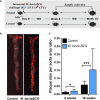Mycobacterium bovis Bacille-Calmette-Guérin Infection Aggravates Atherosclerosis
- PMID: 33391278
- PMCID: PMC7775372
- DOI: 10.3389/fimmu.2020.607957
Mycobacterium bovis Bacille-Calmette-Guérin Infection Aggravates Atherosclerosis
Abstract
Tuberculosis has been associated with increased risk of atherosclerotic cardiovascular disease. To examine whether mycobacterial infection exacerbates atherosclerosis development in experimental conditions, we infected low-density lipoprotein receptor knockout (Ldlr-/-) mice with Mycobacterium bovis Bacille-Calmette-Guérin (BCG), an attenuated strain of the Mycobacterium tuberculosis complex. Twelve-week old male Ldlr-/- mice were infected with BCG (0.3-3.0x106 colony-forming units) via the intranasal route. Mice were subsequently fed a western-type diet containing 21% fat and 0.2% cholesterol for up to 16 weeks. Age-matched uninfected Ldlr-/- mice fed with an identical diet served as controls. Atherosclerotic lesions in aorta were examined using Oil Red O staining. Changes induced by BCG infection on the immunophenotyping profile of circulating T lymphocytes and monocytes were assessed using flow cytometry. BCG infection increased atherosclerotic lesions in en face aorta after 8 weeks (plaque ratio; 0.021±0.01 vs. 0.013±0.01; p = 0.011) and 16 weeks (plaque ratio, 0.15±0.13 vs. 0.06±0.02; p = 0.003). No significant differences in plasma cholesterol or triglyceride levels were observed between infected and uninfected mice. Compared to uninfected mice, BCG infection increased systemic CD4/CD8 T cell ratio and the proportion of Ly6Clow non-classical monocytes at weeks 8 and 16. Aortic plaque ratios correlated with CD4/CD8 T cell ratios (Spearman's rho = 0.498; p = 0.001) and the proportion of Ly6Clow non-classical monocytes (Spearman's rho = 0.629; p < 0.001) at week 16. In conclusion, BCG infection expanded the proportion of CD4+ T cell and Ly6Clow monocytes, and aggravated atherosclerosis formation in the aortas of hyperlipidemic Ldlr-/- mice. Our results indicate that mycobacterial infection is capable of enhancing atherosclerosis development.
Keywords: Bacille-Calmette-Guérin; T cells; atherosclerosis; inflammation; monocytes; mycobacterium; tuberculosis.
Copyright © 2020 Huaman, Qualls, Jose, Schmidt, Moussa, Kuhel, Konaniah, Komaravolu, Fichtenbaum, Deepe and Hui.
Conflict of interest statement
CF has received research support to the University of Cincinnati from Gilead, Pfizer, BMS, ViiV, Janssen, and Merck. The remaining authors declare that the research was conducted in the absence of any commercial or financial relationships that could be construed as a potential conflict of interest.
Figures





References
-
- World Health Organization Global tuberculosis report 2018. Geneva, Switzerland: World Health Organization; (2018).
Publication types
MeSH terms
Substances
Grants and funding
LinkOut - more resources
Full Text Sources
Medical
Research Materials

